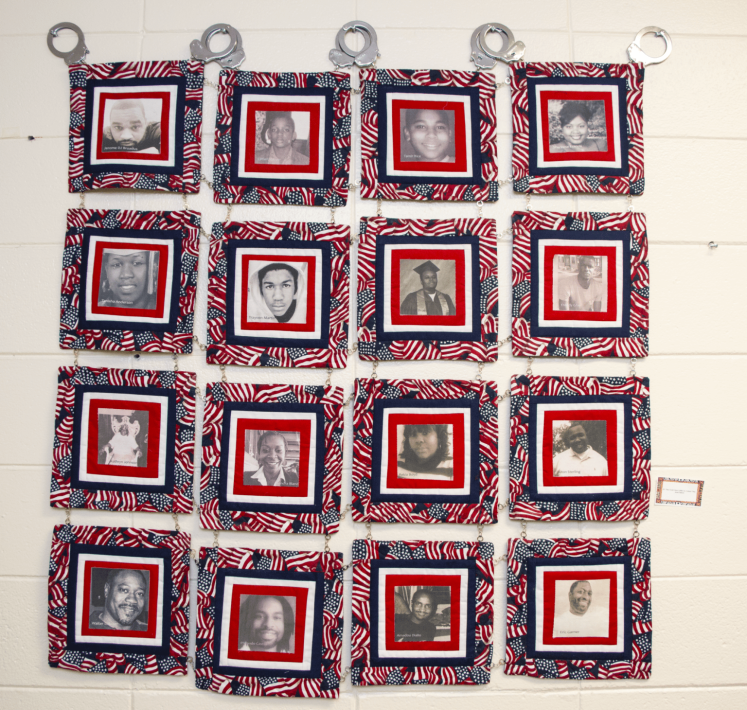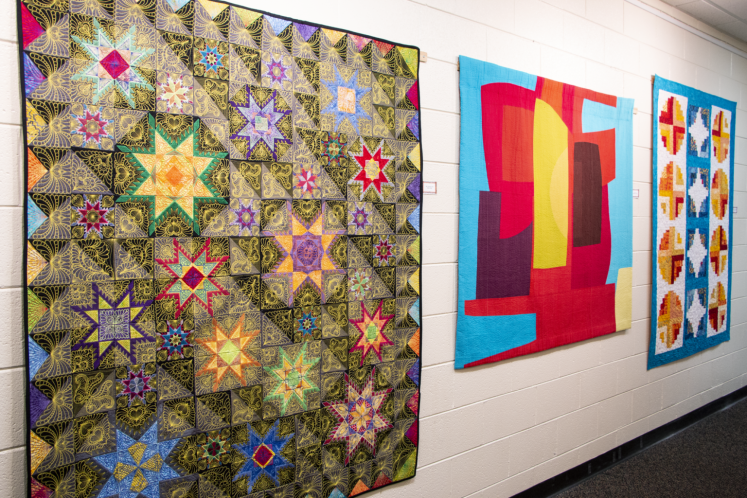ATLANTA, GA–The labyrinth of cement block hallways is spangled with quilts. Each is a soft, brilliant gem against the dull walls. Each shows a different fantasy breathed into life. Some are an exploration of the rhythm of embroidery, the vivid threads weaving patterns of vines and flowers. Others depict a single image–one a bouquet of hand-beaded forget-me-nots, another a little girl dressed for Sunday school. Few are the expected blocks of squares and triangles set off by a border. It’s an exhibit for the Atlanta Quilt Festival–a month-long celebration of stylized African-American quilts through workshops and exhibitions.
“I do view African-American quilting as a genre, just like traditional quilts, art quilts, modern quilts,” Atlanta Quilt Festival Founder O.V. Brantley says. “Our quilts are just a little bit different.”
Brantley founded the quilt show because so few quilt exhibits feature work by Black women, or that express this African-American design style. Traditional quilting has rigid technical standards, which Black quilters sometimes forego in their enthusiasm to express their imagination through fabric. More mainstream traditional quilts tend to be decorated with blocks of geometrical shapes. In the case of appliqué, when sections of fabric are cut to create rounded figures, like animals, the colors and prints are usually softer. They look like what you’d expect to find in a Southern linen closet.
While African-American quilts incorporate these techniques, it’s with the vivid knob turned up several notches. The edges for blocks and borders might be less square, creating a more casual effect. The fabrics are brighter, more prints are combined, and they often draw on African motifs in the overall design. A quilter does not have to be Black to create a quilt in this style. But they’d be the crafting equivalent of a blue-eyed soul singer.

African-American quilts are not simply a set of colors, techniques, or patterns. They’re a celebration of a culture by artists who understand and love it best.
“I’m just trying to spread joy,” Brantley says. “We’re just trying to have a happy quilt show, something that makes people happy when they attend it. No big deep thing–just joyful quilts.”
The festival’s crowning exhibit is held at the South Fulton Art Center. Along the cinderblock hallways hang a multitude of artistic visions. One quilt is a tribute to machine stitching with elaborate golden scrollwork interspersed by colorful stars. Another honors the wisdom and artistry of women often disregarded in the art world due to their age, venerating them in a massive portrait of a gray-haired woman bent over an antique Singer, a quilt bunched across the worktable.
Some are unapologetically political. One small, dark quilt is broken up by a few blocks of patterned cloth; embroidered underneath a house are the words “She needed a house with two front doors.” Another is a row of 16 separate blocks, each column suspended from a pair of silver handcuffs. Printed on each square is the face and name of a Black person who slain by police. Each portrait is framed by red, white, and blue flag fabric.

For Brantley, her 20 years spent quilting have been more about the craft than the creation. Before she retired, the focus and precision that quilting demands helped her unwind from stressful days practicing law.
“Women in particular have always had an urge to express themselves artistically. Many of us sew and paint and craft,” she says. “Quilting was really my therapy. I always say I feel like it saved my sanity.”
She tries to meet as many other Black quilters as she can, and encourages their work.
During the festival awards ceremony, Brantley says this was one of her motivations for creating the festival. More often than not, when she encouraged a friend to submit their work to a festival, the response was, “No, I’m not good enough.”
“That’s why I use the word ‘humble’ a lot with African-American quilters,” Brantley says. “It seems like we always feel like our work is not good enough. Part of my mission is to show that what we do is just as beautiful, perhaps in a different way.”
As with any activity, quilting can be intimidating for beginners. Particularly beginners of color, who may find themselves alone in overwhelmingly white spaces. It was because of this that a group of Atlanta, quilters founded Brown Sugar Stitchers, one of only a few predominantly Black guilds in the area.
Members of Brown Sugar are allowed to also be involved with other guilds in the city, some of which have hundreds of members, and the guild does admit non-Black members. Brown Sugar’s unimposing size creates a warmer environment for beginners, who might struggle to get their feet under them in a larger group.
“Brown Sugar is a little treasure in that regard,” Guild President Elisa Woods says. “It’s an opportunity to be with like-minded people over fabric.”
Like Brantley, Woods thinks Black quilters are often too humble about their art. She wants even the most amateur creators to know that their work matters.
“The points might not match, the lines might not be straight, but you were able to put a top, a batting, and a back [together],” Woods says. “And when you give it, you give with love, and people appreciate it.”
Next year marks Brown Sugar’s 20th anniversary, and the guild is hosting a challenge for members to create quilts that reflect how traditional African-American artistry has influenced their work. The activity is yet another expression of how integral legacy is to quilting. A well-made, and well-loved, quilt can last generations. It’s a love letter to the future.
Part of the soul of quilting is about honoring the past.
“I think there’s been a resurgence in people studying their history in general,” Brantley says. “And I have seen in the community here the numbers attending the festival have exploded. People are interested in being in contact with their roots.”
A spirit of originality has always threaded through the evolution of African-American quilting. One formerly enslaved Georgia woman’s skill and creativity made her one of the most famous names in quilting. Harriet Powers was born in 1837 near Athens, Georgia, according to the Smithsonian Institution. In 1886, she exhibited a quilt at the Athens Cotton Fair. Rather than patterned blocks, the design of choice for most quilts made at the time, each square was decorated with appliquéd figures and symbols depicting different stories from the Bible. The images look like they had grown tired of spending millennia on a chilly stone tablet, and found a new, cozier, home in Powers’s fabric.
The work caught the eye of Southern artist Jennie Smith, who was so amazed by Powers’s artistry that she found Powers and asked to buy the quilt. “I have spent my whole life in the South, and am perfectly familiar with 30 patterns of quilts, but I had never seen an original design, and never a living creature portrayed in patchwork,” Smith wrote. “The scenes on the quilt were biblical and I was fascinated. I offered to buy it, but it was not for sale at any price.”

Because of its striking resemblance to indigenous art, historians have compared Powers’ work to textiles of the West African kingdom of Dahomey. Using a combination of hand and machine stitching and a handful of earth tone fabrics, the minimalist blocks tell the ancient stories of Adam and Eve, Jacob’s ladder, and the Passion of the Christ, among others. It is now preserved at the Smithsonian.
A different kind of minimalism makes the quilts of Gee’s Bend some of the most celebrated in textile history. Officially known as “Boykin,” but called after the nearby turn in the Alabama River, Gee’s Bend is a remote community southwest of Selma. Surrounded by water on three sides, residents have had limited interaction with outsiders for generations, according to the Souls Grown Deep Foundation, an organization that preserves and promotes the work of African-American folk artists in the South, like the Gee’s Bend quilters. Historically, residents were the descendants of slaves who eventually became sharecroppers. This geographical insulation, and the accompanying cultural isolation, gave rise to unique patterns unseen anywhere else.
Powers’s quilt is remarkable because of how it recreated ancient African designs through the advent of a new technique. In contrast, the quilts of Gee’s Bend use long-established piecing methods from the European tradition, such as geometric blocks, in unorthodox ways to create novel patterns. The colorful rows of triangles and rectangles are irregular, and many quilts have uneven borders. Older quilts were made with scraps of flour sacks, denim coveralls, and worn out dresses. Fabrics reflect the skill with which impoverished Southerners find a new use for worn out goods.
The habit of not throwing out anything useful has stayed with today’s Black quilters as they pull from several different traditions at once, incorporating techniques from Powers, Gee Bend, and European traditions. Some quilts exhibit geometric block patterns, while others glitter with beadwork, or depict appliqué figures made from tribal prints. This is what gives modern African-American quilting its unique and vibrant style.
As a historical textile art form, quilting is indelibly linked to the past. Under slavery, Black quiltmakers were obliged to encrypt messages in their quilts. They communicated with one another using signs and symbols both ordinary and supernatural. Now, Black quilters have the freedom to use their art to be boldly political. The 2019 Atlanta Quilt Festival featured quilts inspired by the testimony of Christine Blasey Ford and video footage of Black victims shot by police.

Marla Jackson, executive director of the African-American Quilt Museum and Textile Academy in Lawrence, Kansas, has made a career of celebrating such works. Unlike her foremothers, Jackson has more freedom to cast light into the shadowy corners of history.
She believes the purpose of quilting is “the revolution.”
“[To] talk about social issues, talk about injustices,” she says. “Talk about human rights–all people’s rights.”
She uses her narrative quilts to celebrate the accomplishments of enslaved individuals, and mark the barbarity of Confederate guerillas. One of the quilts she made with her students tells the story of Maria, an enslaved woman who was abducted by Union soldiers during a raid on a Missouri Plantation. Jackson’ quilts are on display at a number of institutions in the Midwest, as well as in the Smithsonian Institution’s Anacostia Community Museum.
Jackson has never taken a traditional approach to quilting. Although her grandmother was a quilter, Jackson didn’t make her first quilt until 1985. One year she went with her predominately-white guild to quilt camp. As a Black woman, she struggled to find her voice in the rigid uniformity of traditional blocks.
“I was appliqueing and beading, and I didn’t know what I was doing. People would be laughing at me, ‘Marla you’re not supposed to!’” she recalls.
Like Harriet Powers, she realized she had to tell her story a different way. “I figured it out,” she says. “It took me to a whole different level.”
Her body of work is an exploration of the myriad ways to create a quilt: hand- and machine-stitching, painting, thread painting, and even trapunto (puffed shapes raised above the quilt top).

Jackson has created quilting programs for youth and parolees, teaching them about history, and the value of their own imaginations.
“I always knew art heals from the inside and it’s an immediate reflection of your soul,” Jackson says. “And that’s why I do it and I advocate for it.”
This is a mission Jackson shares with Brantley and Woods as they all seek to nurture the next generation of Black quilters.
“When I first started quilting 20 years ago, I thought that the art of quilting may be disappearing, so part of the mission has always been to pass on the art of quilting,” Brantley says. “Hopefully to encourage some young person to see a beautiful quilt and say, ‘I can do that. I want to learn how to do that.’”






